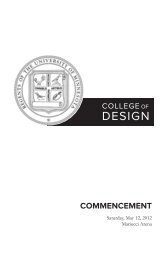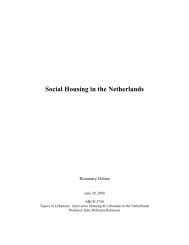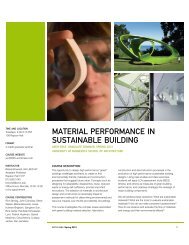THE NEW ARCHITECTURE OF THE SUN AND WIND: - School of ...
THE NEW ARCHITECTURE OF THE SUN AND WIND: - School of ...
THE NEW ARCHITECTURE OF THE SUN AND WIND: - School of ...
You also want an ePaper? Increase the reach of your titles
YUMPU automatically turns print PDFs into web optimized ePapers that Google loves.
Promote Affordability: Mainstream Green<br />
Colorado Court Affordable Housing, Community<br />
Corporation <strong>of</strong> Santa Monica and Pugh Scarpa<br />
Kodama<br />
Can architecture become more ecologically relevant and<br />
help create a sustainable future and society? While the<br />
themes <strong>of</strong> ecology, economy, and equity (the “three Es”)<br />
and planet, prosperity, and people (the “three Ps”) are<br />
common frameworks that embrace a holistic<br />
interpretation <strong>of</strong> sustainability, the economic bottom line<br />
still drives most sustainable design projects and<br />
decisions. To mainstream the next generation <strong>of</strong><br />
sustainable design, we need to address not only<br />
ecological effectiveness, but also a deeper<br />
understanding <strong>of</strong> green economics, equity, and social<br />
justice. Unless this is done, there is a risk <strong>of</strong> creating a<br />
sustainable architecture predominately for the elite. This<br />
risk can be counteracted by balancing all Es, and in<br />
particular elevating sustainable design’s affordability and<br />
justice dimensions. The Colorado Court Affordable<br />
Housing Project in Santa Monica, Calif., by Pugh Scarpa<br />
Kodama, thoughtfully integrates all three issues. As the<br />
first energy-neutral affordable housing project in the<br />
United States, the Colorado Court has ambitious goals:<br />
to optimize ecological benefits, building performance,<br />
social and human factors, and economic considerations.<br />
In addition to bioclimatic and site-responsive design<br />
features that harvest free light, wind, and passive solar<br />
energy on a seasonal basis, the project employs a broad<br />
cross-section <strong>of</strong> renewable and low-carbon-emitting<br />
technologies, including photovoltaic panels and a gasfired<br />
microturbine to produce 100 percent <strong>of</strong> required<br />
electricity on-site. The microturbine also generates hot<br />
water for domestic use and hydronic radiant heating. Air<br />
conditioning is eliminated as a result <strong>of</strong> the welldesigned<br />
natural ventilation, which is achieved through<br />
careful attention to the site, massing, and window<br />
design. The project is more than a technical endeavor;<br />
the attention to the overall building and site design<br />
create pleasing spaces that foster connections to<br />
community and nature. Each unit has an exterior<br />
balcony and a central landscape court provides outdoor<br />
living spaces.<br />
Climate change caused in part by carbon dioxide<br />
emissions has disproportionately impacted nonindustrial<br />
(and low-carbon-emitting) regions <strong>of</strong> the world through<br />
related problems such as drought and flooding.<br />
Increasingly we are also seeing climate-related changes<br />
throughout the world, evidenced by extreme weather<br />
patterns, modified growing seasons, and shifting<br />
ecosystem and habitat boundaries. The moral<br />
Colorado Court exterior view<br />
Photo by Marvin Rand<br />
-9-







